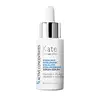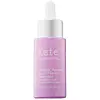What's inside
What's inside
 Key Ingredients
Key Ingredients

 Benefits
Benefits

 Concerns
Concerns

 Ingredients Side-by-side
Ingredients Side-by-side

Water
Skin ConditioningSqualane
EmollientGlycerin
HumectantPPG-24-Glycereth-24
EmulsifyingIsosorbide Disunflowerseedate
HumectantIsosorbide Dicaprylate
Skin ConditioningDimethicone
EmollientCaprylic/Capric Triglyceride
MaskingPropanediol
SolventPanthenol
Skin ConditioningPotassium Cetyl Phosphate
EmulsifyingTremella Fuciformis Sporocarp Extract
AntioxidantAdenosine
Skin ConditioningSodium Acetylated Hyaluronate
HumectantSodium Hyaluronate
HumectantSodium Hyaluronate Crosspolymer
HumectantHydrolyzed Sodium Hyaluronate
Skin ConditioningGlyceryl Stearate
EmollientCetearyl Alcohol
EmollientGlycine Soja Seed Extract
Skin ConditioningStearic Acid
CleansingSodium Lauroyl Glutamate
Hydroxyethyl Acrylate/Sodium Acryloyldimethyl Taurate Copolymer
Emulsion StabilisingXanthan Gum
EmulsifyingTetradecyl Aminobutyroylvalylaminobutyric Urea Trifluoroacetate
Skin Conditioning1,2-Hexanediol
Skin ConditioningPentylene Glycol
Skin ConditioningCaprylhydroxamic Acid
Polyisobutene
PEG-7 Trimethylolpropane Coconut Ether
EmulsifyingEthylhexylglycerin
Skin ConditioningMagnesium Chloride
Disodium EDTA
Citric Acid
BufferingPotassium Sorbate
PreservativeSodium Benzoate
MaskingWater, Squalane, Glycerin, PPG-24-Glycereth-24, Isosorbide Disunflowerseedate, Isosorbide Dicaprylate, Dimethicone, Caprylic/Capric Triglyceride, Propanediol, Panthenol, Potassium Cetyl Phosphate, Tremella Fuciformis Sporocarp Extract, Adenosine, Sodium Acetylated Hyaluronate, Sodium Hyaluronate, Sodium Hyaluronate Crosspolymer, Hydrolyzed Sodium Hyaluronate, Glyceryl Stearate, Cetearyl Alcohol, Glycine Soja Seed Extract, Stearic Acid, Sodium Lauroyl Glutamate, Hydroxyethyl Acrylate/Sodium Acryloyldimethyl Taurate Copolymer, Xanthan Gum, Tetradecyl Aminobutyroylvalylaminobutyric Urea Trifluoroacetate, 1,2-Hexanediol, Pentylene Glycol, Caprylhydroxamic Acid, Polyisobutene, PEG-7 Trimethylolpropane Coconut Ether, Ethylhexylglycerin, Magnesium Chloride, Disodium EDTA, Citric Acid, Potassium Sorbate, Sodium Benzoate
Water
Skin ConditioningGlycerin
HumectantHydrolyzed Yeast Protein
Skin ConditioningButylene Glycol
HumectantPropanediol
SolventCucumis Sativus Seed Oil
EmollientEctoin
Skin ConditioningHydroxyectoin
BufferingCeramide NP
Skin ConditioningCeramide AP
Skin ConditioningCeramide EOP
Skin ConditioningPalmitoyl Tripeptide-8
Skin ConditioningTasmannia Lanceolata Fruit Extract
Skin ConditioningHippophae Rhamnoides Oil
EmollientTocopherol
AntioxidantCholesterol
EmollientEthylhexylglycerin
Skin ConditioningCarbomer
Emulsion StabilisingAspergillus/Molasses Ferment Filtrate
Skin ConditioningPhytosphingosine
Skin ConditioningAdenosine
Skin ConditioningCaprylhydroxamic Acid
Xanthan Gum
Emulsifying1,2-Hexanediol
Skin ConditioningGlycine Soja Extract
Skin ConditioningLecithin
EmollientSclerotium Gum
Emulsion StabilisingPullulan
Dextran
Pentylene Glycol
Skin ConditioningSodium Lauroyl Lactylate
EmulsifyingDisodium EDTA
Silica
AbrasiveSodium Benzoate
MaskingPhenoxyethanol
PreservativeWater, Glycerin, Hydrolyzed Yeast Protein, Butylene Glycol, Propanediol, Cucumis Sativus Seed Oil, Ectoin, Hydroxyectoin, Ceramide NP, Ceramide AP, Ceramide EOP, Palmitoyl Tripeptide-8, Tasmannia Lanceolata Fruit Extract, Hippophae Rhamnoides Oil, Tocopherol, Cholesterol, Ethylhexylglycerin, Carbomer, Aspergillus/Molasses Ferment Filtrate, Phytosphingosine, Adenosine, Caprylhydroxamic Acid, Xanthan Gum, 1,2-Hexanediol, Glycine Soja Extract, Lecithin, Sclerotium Gum, Pullulan, Dextran, Pentylene Glycol, Sodium Lauroyl Lactylate, Disodium EDTA, Silica, Sodium Benzoate, Phenoxyethanol
Ingredients Explained
These ingredients are found in both products.
Ingredients higher up in an ingredient list are typically present in a larger amount.
1,2-Hexanediol is a synthetic liquid and another multi-functional powerhouse.
It is a:
- Humectant, drawing moisture into the skin
- Emollient, helping to soften skin
- Solvent, dispersing and stabilizing formulas
- Preservative booster, enhancing the antimicrobial activity of other preservatives
Adenosine is in every living organism. It is one of four components in nucleic acids that helps store our DNA.
Adenosine has many benefits when used. These benefits include hydrating the skin, smoothing skin, and reducing wrinkles. Once applied, adenosine increases collagen production. It also helps with improving firmness and tissue repair.
Studies have found adenosine may also help with wound healing.
In skincare products, Adenosine is usually derived from yeast.
Learn more about AdenosineCaprylhydroxamic Acid is a chelating agent.
Chelating agents help prevent metal ions from binding to other ingredients. This helps prevent unwanted reactions and effects from using the product.
Caprylhydroxamic Acid is often used with natural antimicrobial products as an alternative to preservatives.
Learn more about Caprylhydroxamic AcidDisodium EDTA plays a role in making products more stable by aiding other preservatives.
It is a chelating agent, meaning it neutralizes metal ions that may be found in a product.
Disodium EDTA is a salt of edetic acid and is found to be safe in cosmetic ingredients.
Learn more about Disodium EDTAEthylhexylglycerin (we can't pronounce this either) is commonly used as a preservative and skin softener. It is derived from glyceryl.
You might see Ethylhexylglycerin often paired with other preservatives such as phenoxyethanol. Ethylhexylglycerin has been found to increase the effectiveness of these other preservatives.
Glycerin is already naturally found in your skin. It helps moisturize and protect your skin.
A study from 2016 found glycerin to be more effective as a humectant than AHAs and hyaluronic acid.
As a humectant, it helps the skin stay hydrated by pulling moisture to your skin. The low molecular weight of glycerin allows it to pull moisture into the deeper layers of your skin.
Hydrated skin improves your skin barrier; Your skin barrier helps protect against irritants and bacteria.
Glycerin has also been found to have antimicrobial and antiviral properties. Due to these properties, glycerin is often used in wound and burn treatments.
In cosmetics, glycerin is usually derived from plants such as soybean or palm. However, it can also be sourced from animals, such as tallow or animal fat.
This ingredient is organic, colorless, odorless, and non-toxic.
Glycerin is the name for this ingredient in American English. British English uses Glycerol/Glycerine.
Learn more about GlycerinPentylene glycol is typically used within a product to thicken it. It also adds a smooth, soft, and moisturizing feel to the product. It is naturally found in plants such as sugar beets.
The hydrophilic trait of Pentylene Glycol makes it a humectant. As a humectant, Pentylene Glycol helps draw moisture from the air to your skin. This can help keep your skin hydrated.
This property also makes Pentylene Glycol a great texture enhancer. It can also help thicken or stabilize a product.
Pentylene Glycol also acts as a mild preservative and helps to keep a product microbe-free.
Some people may experience mild eye and skin irritation from Pentylene Glycol. We always recommend speaking with a professional about using this ingredient in your routine.
Pentylene Glycol has a low molecular weight and is part of the 1,2-glycol family.
Learn more about Pentylene GlycolPropanediol is an all-star ingredient. It softens, hydrates, and smooths the skin.
It’s often used to:
Propanediol is not likely to cause sensitivity and considered safe to use. It is derived from corn or petroleum with a clear color and no scent.
Learn more about PropanediolSodium Benzoate is a preservative. It's used in both cosmetic and food products to inhibit the growth of mold and bacteria. It is typically produced synthetically.
Both the US FDA and EU Health Committee have approved the use of sodium benzoate. In the US, levels of 0.1% (of the total product) are allowed.
Sodium benzoate works as a preservative by inhibiting the growth of bacteria inside of cells. It prevents the cell from fermenting a type of sugar using an enzyme called phosphofructokinase.
It is the salt of benzoic acid. Foods containing sodium benzoate include soda, salad dressings, condiments, fruit juices, wines, and snack foods.
Studies for using ascorbic acid and sodium benzoate in cosmetics are lacking, especially in skincare routines with multiple steps.
We always recommend speaking with a professional, such as a dermatologist, if you have any concerns.
Learn more about Sodium BenzoateWater. It's the most common cosmetic ingredient of all. You'll usually see it at the top of ingredient lists, meaning that it makes up the largest part of the product.
So why is it so popular? Water most often acts as a solvent - this means that it helps dissolve other ingredients into the formulation.
You'll also recognize water as that liquid we all need to stay alive. If you see this, drink a glass of water. Stay hydrated!
Learn more about WaterXanthan gum is used as a stabilizer and thickener within cosmetic products. It helps give products a sticky, thick feeling - preventing them from being too runny.
On the technical side of things, xanthan gum is a polysaccharide - a combination consisting of multiple sugar molecules bonded together.
Xanthan gum is a pretty common and great ingredient. It is a natural, non-toxic, non-irritating ingredient that is also commonly used in food products.
Learn more about Xanthan Gum